|
I've always been skeptical about the so-called cryptozoology.
I do not believe in yeti, bigfoot, Nessie, Ogopogo, Mokele-Mbembe, curupuri, or
other creatures supposed to be hiding in deep lakes, high mountains or dense rainforests.
I think they all belong to fairy tales, together with flying saucers, Bermuda
Triangle, ghosts, gods of all religions, and voodoo spirits. There are lots of
creatures on our planet that scientists haven't discovered yet, but they are mostly
of little or no interest to general public. Only zoologists are interested in
them, and only zoologists discover them from time to time. As soon as you hear
about "professional cryptozoologists", or "yeti experts",
you can be sure there is some con science involved. But if you start studying
microscopic roundworms, or, say, soil beetles, you can sometimes describe a new
species from your backyard, or few hundred new species during one month in tropical
forests.

Most of Puerto Rico can be seen from mountain
tops of Cordillera Central. |
In late 1999, we had to cancel our trip to Mexico, and decided
to visit Puerto Rico instead. We didn't plan any scientific research, just little
hiking, birdwatching, caving, scuba diving, and a lot of sunbathing. We had no
equipment with us, except for snorkels, masks, and flashlights. I had almost no
time to collect some information about flora and fauna of the island, and what
I could find, was interesting, but sad. |
| Once upon a time, Puerto Rico was among our planet's most wonderful
biodiversity centers. Together with other Antilles, it became disconnected from
both American continents millions of years ago, and slowly moved eastwards, carrying
many ancient inhabitants of the Neotropics. Later on, the relatives of island
species on the mainland evolved or became extinct, but some of them survived on
the islands. |
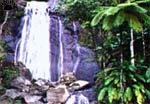
Waterfalls and tree ferns in El
Yunque, Caribbean Nat. Forest. |

Lizard-cuckoo, Guanica. |
Among the "living fossils" were terrestrial sloths,
solenodons, primitive shrews, and many interesting rodents. However, this splendid
fauna didn't include any large carnivorous mammals. Prior to the arrival of humans,
the island's largest terrestrial predators were boas (Boa constrictor),
hawks (Buteo), and Puerto Rican lizard-cuckoo (Saurothera vieilloti).
|
| After European colonization, the island shared the fate of many
other "Lost Worlds", and lost most of endemic fauna to hunting, deforestation,
introduced species, and other reasons. It was hit even more heavily than other
Greater Antilles, because of its small size (only 160x56 km/100x35 miles), and
the longest history of colonization (it was the first one to be settled by Europeans).
In the early 1900-s, only 1% of the original forests remained. The decline in
local agriculture resulted in gradual reforestation, so the island is now 40%
forested. But this change came too late for many local plants and animals. |
 |
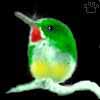 |
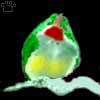 |
Puerto Rican tody
(Todus mexicanus) is
one of the few surviving
endemics of the island. |
|
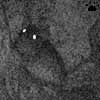 |
 |
Black rat (Rattus rattus)
is now abundant
throughout the island, from rainforest canopy to
deep caves. Cueva del Vienta, Cambalache Forest. |
|
Among other things, Puerto Rico lost all its mammals, except
for bats and manatees (some of them were hunted down to extinction by local Taino
people prior to the arrival of the Europeans). Now the only terrestrial mammals
in the island forests are introduced mongooses, European black rats, feral cats
and few other "illegal immigrants". |
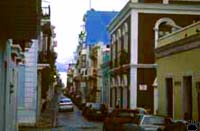 |
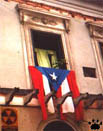 |
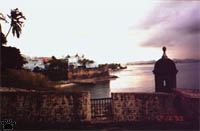
|
| San Juan - the oldest
European city in Americas (founded 1493). |
| Despite the losses, the island has enough interesting things to attract an
attention of a naturalist. Its mountains are still largely forested; its coral
reefs are mostly in good condition; its birds, plants, amphibians, and invertebrates
are unique and beautiful. Besides, it is a peaceful country with friendly people
and well-developed infrastructure. So, many biologists have been working here,
and many of local students have become naturalists, too. There are many Nature
reserves here, and some programs are underway to save the island's endangered
plants and animals. |

Forests of Maricao Preserve,
Puerto Rico. |
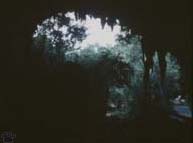
Camuy Caves, Puerto Rico. |
You would expect such a place to be thoroughly studied, but,
amazingly, the island is famous in "cryptozoological" circles. It is
one of the areas where "el chupacabra", the demonic blood-sucking monster
of Tropical America, is believed to appear most often. Unfortunately, the topic
was "highjacked" by ufologists and other con scientists as soon as it
became a focus of public interest, so no serious research was ever done. There
is probably nothing behind this myth; but there are some more real mysteries in
Puerto Rico, too. |
| In 1957, one of the island's bat species, presumed to be extinct,
was found on Puerto Rico and adjacent islands. Many new cave animals have been
found in the extensive cave systems. What is even more
intriguing, some experts believe that at least one native rodent, Isolobodon
portoricensis, have still been existing on the island in the 1980-s. This
guinea pig-size animal was once semi-domesticated by native people. They have
probably brought it from Hispaniola many centuries ago. By the time of European
arrival, it was abundant on both islands, but introduced mongooses soon wiped
it out. Its presence on Puerto Rico was last documented in early 20th century. |
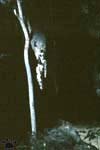
Giant stalactites at the
entrance to Camuy Cave. |

Guanica Dry Forest, Puerto Rico. |
Guanica Forest Reserve on the island's
Southern coast is one of the most interesting Natural areas of Puerto Rico, but
definitely not your prime choice if you are interested in cryptozoology. It has
unique flora and fauna (some of local plants exist nowhere else in the World),
but it is small, easily accessible, crossed by paved roads, and regularly visited
by birdwatchers. We spent a lot of time here, too - not only looking for rare
species, but also enjoying its small, quiet beaches, popular among locals but
almost unknown to gringo tourists. |
 |
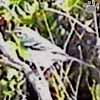 |
 |
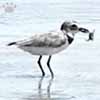 |
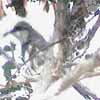 |
| Birds of Guanica Forest
Reserve, top to bottom, upper row: Pelecanus occidentalis, Elaenia martinica,
Margarops fuscatus (2 photos), Ardea tricolor; middle row: Quiscalis
niger, Icterus dominicensis, Spindalis zena, Melanerpes portoricensis, Chordeiles
gundlachii, unknown rail, Tiaris bicolor, I. icterus,
Vireo latimeri; bottom row: Coccyzus minor, Dendroica adelaidae, Columbina
passerina, Charadrius wilsonia killing a crab, Coccyzus americanus. |
| One night, I was patrolling a dirt road leading to "our"
beach, in search of Puerto Rican nightjar (Caprimulgus noctiferus), a cute
nocturnal bird that now survives only in Guanica area. I didn't seen it that night,
but I found some nice snails, and saw a native species of small owl (Otus nudipes).
I had descended all the way to the beach, and had turned back already, when I
suddenly saw a woodrat-like animal on a low branch. You can imaging my feelings
when I realized that it was not an introduced Old World rat (Rattus), but
something different - on an island with supposedly no native rodents in existence! |
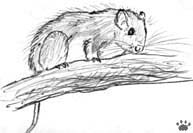
The original sketch of the mystery rodent,
Guanica Dry Forest. |
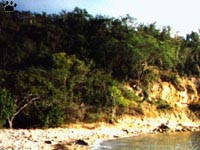
Playa Jaboncillo, the location of the first sighting. |
I could observe it for some time, as the
animal was very tame, but I had no camera to take a picture. So, I had to draw
it, the way naturalists had had to before the invention of photography. The shadows
of great biologists and explorers of the Past stood laughing behind my back, as
I tried to make these pictures look more like the animal I'd seen. Anyway, I have
informed some people interested in Caribbean mammals (including Dr. C. A. Woods,
leading expert on Antillean rodents), about this observation and its precise
location. |
| In July 2000, we came back to Guanica, armed
with camcorder, rat trap, trapping permit, and lots of flashlight batteries. Every
night, we would set our trap, baited with bread and peanut butter, or a banana,
or an apple, and then hike around, listening for every sound, and coming back
once an hour to check the trap. It was a difficult process, because there were
lots of small, but noisy creatures around. The main problem, however, was the
abundance of black rats in the area - they made a lot of noise, but were difficult
to see. We had to spend few minutes every time to pinpoint the source of noise,
and make sure it was a "wrong" rodent again. For the same reason, our
trap proved useless - every time we checked it, there was a fat black rat inside,
helping itself on our bait. Our permit did not include removal of rats, so we
watched helplessly as some individuals got themselves trapped 3-5 times in one
night. |
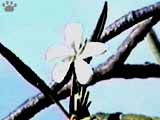

Guanica plants: aleli (Plumeria alba),
melon cactus (Melocactus intortus). |
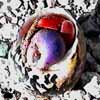 |
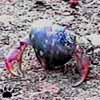 |
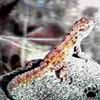 |
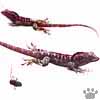 |
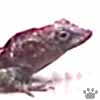 |
 |
Noise-makers of Guanica dry forest,left
to right, top row: hermit crabs (Coenobita clypeatus, in Cittarium pica
seashell, 2 photos), ground gecko (Sphaerodactilys sp.), anole lizards
(Anolis cristatellus, two photos); bottom row: house mouse (Mus
musculus), Jamaican fruit bats (Artibeus jamaicensis). |
 |
|
Our expedition after a night of rat search. |
After many nights of finding nothing, both of us were completely
exhausted, despite spending days on a nice beach. But than, I finally spotted
"our" rodent crossing a road far upslope from the site of the first
observation (see map). We moved our search/trapping efforts
to a dry, densely forested canyon, and next night I finally got a good look -
and, more importantly, some video footage - of the "mystery rat". Actually,
rats - there was a whole family of them, mother with two young animals. Surprisingly,
the youngsters had different color - they were blackish, while the adult animal
was gray, just as the one I'd seen in December 1999. |
 |
 |
 |
 |
 |
Snapshots from the videotape of the
mystery rodent. As you can see, the animals were relatively tame (although less
so than black rats): some of the pictures were taken from a distance of only 3
m (10'). Only one of the young animals got videotaped - they spent more time under
cover of dense vegetation (bottom row). Larger images can be seen here.
Note that the animal seems smaller than it was, because its eyes reflect light
and seem larger. For some reason, the tail looks dark, although it was covered
with short silvery fur. |
 |
 |
 |
 |
 |
| I still do not know what species it was. Most Puerto Rican rodents, including
Isolobodon, have never been seen by scientists, except as skulls and bones,
so nobody knows exactly what they've looked like. Besides, it could be an "unregistered"
introduced species, such as a woodrat (Neotoma) from North America, or
some South American rodent. Hopefully, sooner or later somebody will be able to
trap it. Until that time, I prefer to call it "Neotoma sp.",
although I was unable to find any North American species of woodrat that would
be an exact match. I'm waiting for experts to tell us what they think. |
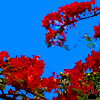 |
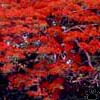 |
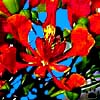 |
Flamboyan tree (Delonix
regia) was introduced to
Puerto Rico from
Madagascar, and widely
naturalized in local
forests. |
|
Pictures of unidentified rail we videotaped in mangroves of
Guanica Forest can be seen here.
In 2002, I received some unexpected updates
on the subject - please look here
Home
|